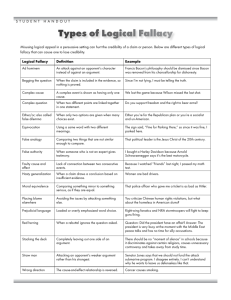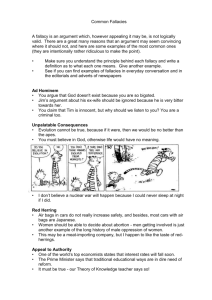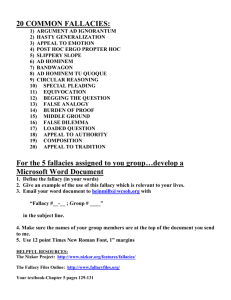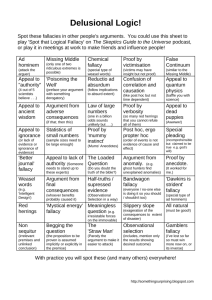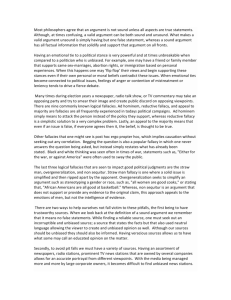Logical Fallacies - Colonel By Secondary School
advertisement
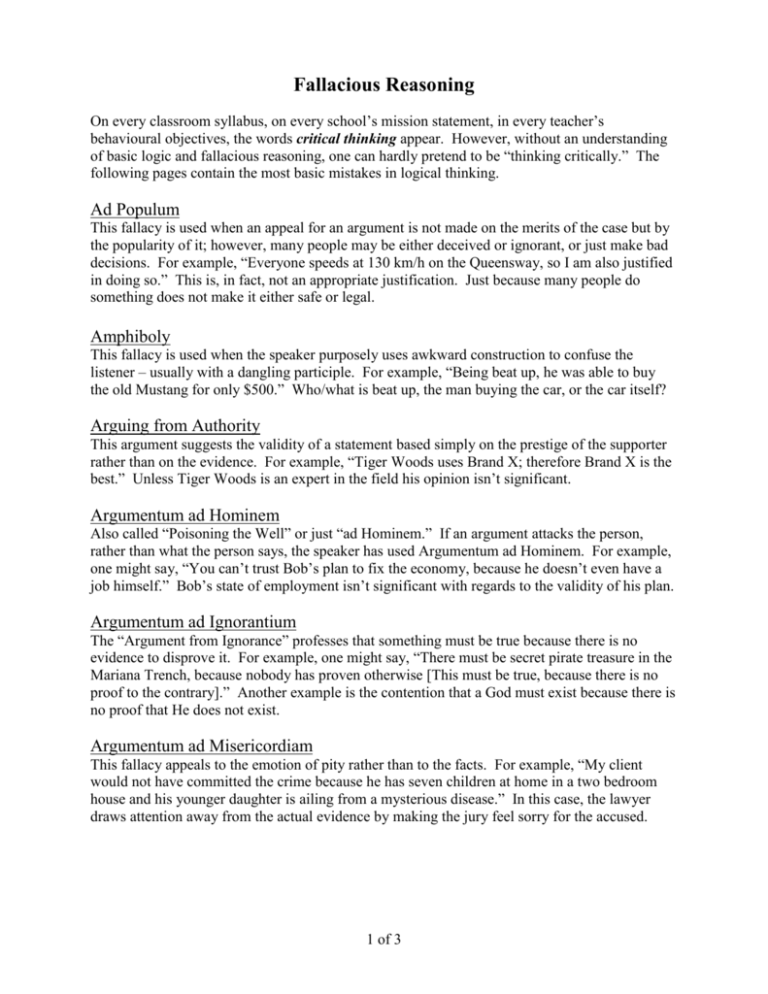
Fallacious Reasoning On every classroom syllabus, on every school’s mission statement, in every teacher’s behavioural objectives, the words critical thinking appear. However, without an understanding of basic logic and fallacious reasoning, one can hardly pretend to be “thinking critically.” The following pages contain the most basic mistakes in logical thinking. Ad Populum This fallacy is used when an appeal for an argument is not made on the merits of the case but by the popularity of it; however, many people may be either deceived or ignorant, or just make bad decisions. For example, “Everyone speeds at 130 km/h on the Queensway, so I am also justified in doing so.” This is, in fact, not an appropriate justification. Just because many people do something does not make it either safe or legal. Amphiboly This fallacy is used when the speaker purposely uses awkward construction to confuse the listener – usually with a dangling participle. For example, “Being beat up, he was able to buy the old Mustang for only $500.” Who/what is beat up, the man buying the car, or the car itself? Arguing from Authority This argument suggests the validity of a statement based simply on the prestige of the supporter rather than on the evidence. For example, “Tiger Woods uses Brand X; therefore Brand X is the best.” Unless Tiger Woods is an expert in the field his opinion isn’t significant. Argumentum ad Hominem Also called “Poisoning the Well” or just “ad Hominem.” If an argument attacks the person, rather than what the person says, the speaker has used Argumentum ad Hominem. For example, one might say, “You can’t trust Bob’s plan to fix the economy, because he doesn’t even have a job himself.” Bob’s state of employment isn’t significant with regards to the validity of his plan. Argumentum ad Ignorantium The “Argument from Ignorance” professes that something must be true because there is no evidence to disprove it. For example, one might say, “There must be secret pirate treasure in the Mariana Trench, because nobody has proven otherwise [This must be true, because there is no proof to the contrary].” Another example is the contention that a God must exist because there is no proof that He does not exist. Argumentum ad Misericordiam This fallacy appeals to the emotion of pity rather than to the facts. For example, “My client would not have committed the crime because he has seven children at home in a two bedroom house and his younger daughter is ailing from a mysterious disease.” In this case, the lawyer draws attention away from the actual evidence by making the jury feel sorry for the accused. 1 of 3 Begging the Question Also called “Circular Argumentation.” One begs the question when one employs the same statement as a premise and a conclusion, or when one assumes the conclusion to be true and bases a premise on that conclusion. For example, “I like ice cream because it’s my favourite food [I like ice cream because I like ice cream]” or “People should care for the less fortunate because it’s the right thing to do [people should care because people should care].” Black and White, a.k.a. “False Dichotomy” The argument which employs the fallacy of black and white sees only extremes and no middle ground, as if there are only two choices. For example, “You’re either with us, or you’re against us,” as if there is no other position possible. Another example: “You either hate Twilight or you love it.” Composition The fallacy of composition occurs when a person asserts that what is true of a part is true of the whole. For example, a person sees one elderly person who is a bad driver and, as a result, assumes that all elderly people are bad drivers. This is similar to a Hasty Generalization in that it is based on limited evidence; the main difference is that with the former the two parts are the same (i.e. eldery persons). Division Also called “Dicto Simplicter.” The fallacy of division occurs when someone assumes that what is true of the whole is necessarily true of every part. For example, “We live in a rich country. Therefore, every citizen of our country is rich.” Equivocation A person equivocates when that person uses the same word in two different senses or when a single word can be interpreted more than one way. For example, “Aspirin can make noisy children go away. After all, noisy children are a headache, and aspirin makes headaches go away” or “Everything that runs has feet. A river runs. Therefore, a river has feet.” While these are obviously humourous cases, equivocation can also be used in serious instances and sometimes is quite deliberately misleading. False Analogy A person uses a false analogy when that person compares two things which are not necessarily the same. For example, a student might claim that since a carpenter can look at blueprints while he is building a house, the student should be able to use notes while taking a test. These are, in fact, not similar situations at all. Hasty Generalization This fallacy calls for a conclusion before sufficient evidence is collected. For example, “The last two times were at a movie, kids were talking loudly the whole time. Therefore, we should avoid movies.” There is no reason to conclude that at future movies things will also be noisy. 2 of 3 Ignoratio Elenchi Also known as “Irrelevant Conclusion.” This fallacy occurs when an argument proposes to prove one thing, but instead concludes with something else. For example, “I will prove to you that my client is not a murderer. He donates generously to the Children’s Wish Foundation, and spends his Christmas season helping at a soup kitchen. Therefore, my client is a generous man.” While the conclusion may well be true, it still doesn’t prove that the client isn’t a murderer. Non Sequitur Literally, non sequitur means “does not follow” and so most fallacious arguments contain some kind of non sequitur. In particular, non sequitur occurs when the premises of an argument are true, but the conclusion does not logically follow. For example, someone might say, “I am a very good driver” (true); “I have never been in an accident (true); then concludes “I am safe to drive on the highway at two hundred kilometres per hour (false).” Post Hoc An argument which uses post hoc establishes a cause-effect relationship simply because one event precedes another in time. For example, “I walked under a ladder. Then I tripped and hurt my ankle. Walking under the ladder brought me bad luck.” Or: The Conservatives pass a new tax reform law that benefits wealthy Canadians. Shortly thereafter the economy takes a nose dive. The NDP claim that the tax reform caused the economic woes and they push to get rid of it. (There may not be any connections at all, but there is a tendency to associated cause and effect because one preceded the other.). Slippery Slope This fallacy takes its name from a sad situation where one loses footing, begins to slide, and cannot regain control – as on an icy slope. It applies when one foresees consequences well beyond what is logical. For example, “If I don’t study, I’ll fail this test. If I fail this test, I won’t get the course credit. If I don’t get the course credit, I won’t get a high school diploma. If I don’t get a diploma, I’ll never get into university. If I never get into university, I’ll have to work at McDonald’s forever.” There is too big a gap between the final conclusion and the first premise for the whole argument to be true, [i.e. “If I fail this test, I will have to work at McDonald’s forever”] though individual arguments may be true [i.e. “If I don’t get a diploma, I’ll never get into university.”]. Statistics Statistics can easily be manipulated to make almost any point. For example, we could easily show that many German soldiers ate pickles in World War II. So did the Americans in Vietnam. So did the Austro-Hungarians in World War I. Therefore, we can (falsely) conclude that pickles were the cause of their losses. It is an obvious misinterpretation of the data to support a false conclusion. This is also clearly a non sequitur (as are all fallacious arguments). Straw Man This fallacy is used when one attacks a position similar to, but different from that of his/her opponent. For example, a person that supports Free Speech allows that adult-only theatres should exist on that basis. An opponent may then falsely claim that the person is in support of pornography. (This may or may not actually be the case – the person actually supports Free Speech and that there should be theatres in which minors are not allowed.) 3 of 3
